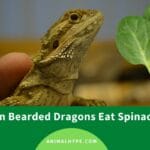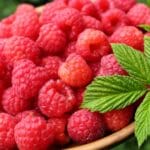Is Lettuce Good for Bearded Dragons?
You’re probably here because you’re wondering, “Can bearded dragons eat lettuce?” It’s a common question, especially for new beardie owners. While lettuce might seem like a healthy, leafy green option, the truth is a bit more nuanced. While your bearded dragon can technically eat some types of lettuce, it’s generally not recommended as a staple food. Think of it like this: lettuce is the junk food of the bearded dragon world – okay as a very occasional treat, but not something to build a diet around. Let’s dive into the details and explore the dos and don’ts of lettuce for bearded dragons.
Decoding Lettuce Varieties: The Good, the Bad, and the Leafy
Not all lettuce is created equal. Some varieties are less harmful than others, but none offer the nutritional powerhouse your dragon needs to thrive.
Iceberg Lettuce: This crispy, watery lettuce should be avoided entirely. It’s extremely low in nutritional value and can cause digestive upset, including diarrhea, due to its high water content.
Butter Lettuce, Bibb Lettuce, and Green Leaf Lettuce: These varieties are slightly better than iceberg, offering marginally more nutrients. However, they still fall short of providing the balanced nutrition your dragon requires and should only be offered very sparingly.
Romaine Lettuce: While often touted as the “best” lettuce for bearded dragons, even romaine lettuce lacks substantial nutritional value compared to other leafy greens. It can be offered occasionally in small amounts, but it shouldn’t be considered a dietary staple.
Want to know if citrus fruits are safe for your beardie? Discover the juicy truth about whether can bearded dragons eat oranges. Curious about adding some green goodness to their diet? Learn if can bearded dragons eat parsley and provide them with a nutritious and delicious meal.
The Nutritional Lowdown: Why Lettuce Doesn’t Cut It
Bearded dragons need a diet rich in vitamins, minerals, and calcium to support their growth, bone health, and overall well-being. Lettuce, unfortunately, falls short in providing these essential nutrients.
Here’s a comparison of the nutritional content of various greens:
| Green | Vitamin A | Calcium | Fiber | Other Benefits |
|---|---|---|---|---|
| Iceberg Lettuce | Very Low | Very Low | Low | Primarily water |
| Romaine Lettuce | Low | Low | Moderate | Minimal vitamins and minerals |
| Collard Greens | High | High | Moderate | Rich in Vitamin K, important for blood clotting |
| Dandelion Greens | High | High | High | Good source of fiber, aids digestion |
| Mustard Greens | Moderate | Moderate | Moderate | Contains antioxidants, supports the immune system |
| Turnip Greens | High | Moderate | Moderate | Source of Vitamin C, boosts immune health |
| Escarole | Moderate | Moderate | Moderate | Contains folate, important for cell growth and repair |
As you can see, nutrient-rich greens like collard greens, dandelion greens, and mustard greens significantly outperform lettuce in terms of nutritional value.
The Risks of a Lettuce-Heavy Diet
While a small amount of romaine lettuce occasionally likely won’t harm your bearded dragon, a diet high in lettuce can pose several risks:
- Nutritional Deficiencies: Lettuce lacks the essential vitamins and minerals necessary for a bearded dragon’s health. A diet primarily consisting of lettuce could lead to serious health issues over time.
- Digestive Problems: The high water content of lettuce, especially iceberg lettuce, can cause diarrhea and dehydration.
- Metabolic Bone Disease (MBD): A calcium-deficient diet, which can result from relying on lettuce, is a leading cause of MBD in bearded dragons. MBD can cause weakened bones, deformities, and a host of other health complications.
Leafy Green Superstars: The Best Alternatives to Lettuce
So, if lettuce isn’t ideal, what should you feed your bearded dragon? Aim for a variety of dark, leafy greens packed with nutrients:
- Collard Greens: A nutritional powerhouse rich in vitamins A, C, and K, as well as calcium and fiber.
- Dandelion Greens: Another excellent source of vitamins and minerals, with the added benefit of aiding digestion.
- Mustard Greens: A good source of antioxidants that can support the immune system.
- Turnip Greens: A good source of vitamin C and other essential nutrients.
- Escarole: A crunchy and nutritious option containing folate, which is important for cell growth and repair.
Preparing Greens and Vegetables
Always wash all greens and vegetables thoroughly to remove any pesticides or dirt. Chop them into bite-sized pieces appropriate for your dragon’s size to prevent choking hazards.
A Balanced Diet: The Key to a Happy, Healthy Bearded Dragon
Remember, variety is crucial. A healthy bearded dragon diet consists of a mix of appropriate insects (especially for juveniles), a variety of nutritious leafy greens, and occasional fruits.
When in Doubt, Consult a Professional
Every bearded dragon is unique, and their dietary needs may vary based on age, health, and individual factors. If you have any concerns about your dragon’s diet, consult a reptile veterinarian. They can provide personalized advice and the most up-to-date information based on the latest research.
By prioritizing a balanced and nutritious diet, you can ensure your bearded dragon lives a long, healthy, and happy life.
- Discover Long Black Pepper: Flavor & Health Benefits - April 25, 2025
- Shocking Twists: The Grownup Review: Unreliable Narration - April 25, 2025
- A Quiet Place Book vs Movie: A Deep Dive - April 25, 2025
















